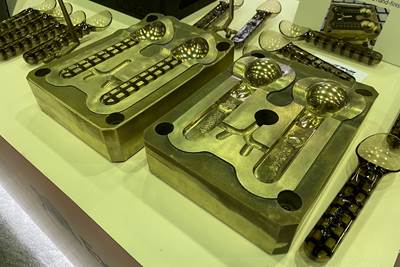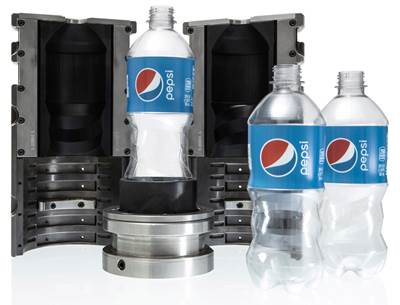For the well-known consumer products company PepsiCo (maker of, among other brands, Pepsi-Cola), prototype blow mold tooling is a vital resource for new product development. Max Rodriguez, senior manager of Global Packaging R&D, Advanced Engineering and Design at the company’s research center in Valhalla, New York, describes how a new bottle design must prove itself: “Our bottling lines run 600 to 800 bottles per minute, and there can be a lot of downtime if bottles are unstable. So we look for optimal center of gravity and contact surface for line stability,” he says. Then, the same bottles have to prove they work well in vending machines. Plus there is the blow molding process itself, and the need to work out the best molding parameters prior to full production. Because of all these factors, the chance to mold several hundred or thousand of a new bottle design for testing, then that many more when this design is inevitably tweaked, is a crucial step in bringing new packaging to market.
The impediment, of course, is the cost and time necessary for mold tooling. Obtaining a prototype metal blow mold tool has traditionally entailed 6 weeks of lead time, at a cost of up to $10,000, according to Rodriguez and R&D packaging engineer Thangthip Tekanil, to whom I spoke for this story. For the PepsiCo team, making short-run blow mold tooling through polymer additive manufacturing seemed to offer a faster and less expensive way to fill this need.
Except it didn’t — not at first. Early 3D printed blow molds made on various polymer additive platforms were capable of only around 200 samples before the tool failed; they couldn’t come close to doing the job the conventional tooling could. That was about four years ago, Rodriguez says.
More recently, two significant developments have succeeded in realizing fast, effective, low-cost prototype blow mold tooling via AM. One is a material advance and the other is an innovation patented by PepsiCo: a hybrid mold applying 3D printing strategically rather than using it to create the entire tool.
These two innovations are now changing the way PepsiCo develops packaging. In place of 6 weeks, the PepsiCo team was recently able to obtain prototype tooling for a new bottle design in just 48 hours — tooling able to mold around 10,000 samples. And in place of $10,000, this AM-enabled tooling instead cost only about $350.
Photopolymer Backed by Stone
The advanced material used in this solution is xPEEK147 from Henkel Loctite. This polymer is “a big breakthrough,” Rodriguez says, a material that can be 3D printed quickly with high dimensional precision and the high-temperature strength for molding applications. Using a Nexa3D NXE 400 photopolymer 3D printer building with this material, the PepsiCo team can produce a complete mold set in about 8 hours of 3D printing followed by 4 hours of curing.

A 3D printed mold set produced in about 12 hours mounts within a universal shell to complete the tool. Photo courtesy of Nexa3D.
The mold forms made this way capture only the bottle geometry, not the entire structure of the mold. PepsiCo’s innovation for prototype molding optimizes strength and reduces cost by containing the 3D printed mold set within a universal metal mold shell that fits standard blow molding machines. The 3D printed forms are backed by dental stone (gypsum used for dental dies) for strength and stability within this shell against molding pressure that can reach 40 bar.
Part of what drives the need for more prototyping and product development in PepsiCo is the company’s commitment to sustainability, including goals it has set for reduced material use. “From a sustainability perspective, the possible changes that we can make are bottle design, preform design, material or process changes. Having the ability to rapidly prototype allows us to find the best solution through one or more changes to these drivers,” Rodriguez says. For example, reengineering bottle designs potentially offers the chance to increase the amount of recycled PET content in each bottle, reducing the need for virgin material. However, this change in material content leads to bottle geometry changes and blow molding parameter changes, both of which have to be tested and refined. Additive manufacturing for tooling is making this sustainability-related exploration faster and cheaper.
“In just a couple days, we can now get a tool to blow only the quantity needed to get samples to all the stakeholders for real-time feedback,” Rodriguez says. That feedback leads to changes, likely necessitating another 3D printed prototype tool. With the speed at which AM tooling can be obtained, multiple iteration loops can now occur in one week, rather than multiple weeks being needed for each loop.
So far, the AM tooling is only for prototyping. The next step the researchers see is bridge production.
Rodriguez’s team has seen 14,000 samples produced by a 3D printed mold set that could have gone further still, but he says, “We need to significantly improve this.” One possible path he sees to raising this tool life is coating the tooling sets. “If we could increase that quantity to 100,000 bottles per 3D printed mold, then that is of great interest to us,” he says. “At that quantity, we could send products to stores from the low-cost mold tooling, and do test marketing.”
Related Content
PowderCleanse Concept Delivers In Situ Powder Analysis for Metal 3D Printing
A collaborative project developed a prototype solution for measuring particle size distribution on the production floor, as part of the sieving step typical to additive manufacturing processes using metal powders.
Read MoreIndyCar's 3D Printed Top Frame Increases Driver Safety
The IndyCar titanium top frame is a safety device standard to all the series' cars. The 3D printed titanium component holds the aeroscreen and protects drivers on the track.
Read MoreFaster Iteration, Flexible Production: How This Inflation System OEM Wins With 3D Printing
Haltec Corp., a manufacturer of tire valves and inflation systems, finds utility in 3D printing for rapid prototyping and production of components for its modular and customizable products.
Read MoreTitanium Golf Club Line Leverages AM to Boost Clubhead Performance
Japanese lifestyle golf brand Designer utilizes Farsoon 3D printing to optimize the design and production of its latest titanium golf club line.
Read MoreRead Next
Binder Jetting Is Also a Tooling Technology
A portfolio of 3D printing solutions involving infiltrated sand and metal covers tooling needs for casting, thermoforming, molding and composites.
Read MoreHow to Build 10,000+ Shot Molds in Hours
Rapid tooling isn’t so rapid when it takes days to 3D print a metal mold, and then you still must machine it to reach the necessary tolerances. With Nexa3D’s polymer process you can print a mold in hours that is prototype or production ready and can last for more than 10,000 shots.
Read More3 Types of 3D Printed Tooling for Injection Molding: AM Radio #16A
3D printed tooling for injection molding, including mold inserts, components and end of arm tooling, were on display at the Plastics Technology Expo.
Read More






















